Vancouver, British Columbia--(Newsfile Corp. - October 5, 2022) - Tower Resources Ltd. (TSXV: TWR) ("Tower" or the "Company") is pleased to provide an update on the recent step-out diamond drilling program (see Tower's September 15, 2022 press release) on the Lightning Zone on the Company's Rabbit North property near Kamloops, British Columbia, between New Gold's New Afton underground Cu-Au mine and Teck's Highland Valley open pit Cu-Mo mine (see Fig. 1). While performing the drilling, Tower collected two till samples that revealed a new, much coarser grained (see Fig. 2) and thus higher grade gold dispersal train 400m west of the Dominic Lake Train (see Fig. 3) that emanates from the Lightning Zone (see Fig. 4) and led to its discovery.
New Dispersal Train
The new dispersal train has been named the Central Train because it lies midway between the Dominic Lake and Durand Creek Trains (see Fig. 3). The two new till samples from the train, Nos. 245 and 246, yielded 318 and 301 gold grains, respectively, including many coarse, sand-sized grains that contribute much more Au than the usual silt-sized grains. They were collected up-ice (northwest) at 30 m step-outs from a 169-grain gold anomaly that was obtained from Sample 068 in (see Fig. 3) in Tower's inaugural , 137-sample reconnaissance till survey in May, 2021 (see Tower's August 10, 2021 press release).
Implications of the High Au Grade of the Till for the Au Grade of the Source Rocks
Tower's till sampling and sample processing contractor, Overburden Drilling Management Limited (ODM), has studied many gold grain dispersal trains over nearly 50 years. For trains as significant as those at Rabbit North, ODM has determined that the Au grade of the heavy mineral fraction of the till where the gold grains reside, calculated from the number of grains recovered from a sample and the measured dimensions of these grains, is predictive of the grade of the bedrock source from which the grains are derived, provided that the grade is normalized to the average 0.4% (1 particle in 250) heavy mineral content of till in Canada.
The grades of the Dominic Lake Train and its source, the Lightning Zone, uphold the above relationship, indicating that it should also apply to the new, richer Central Train. The average normalized Au grade of the heavy mineral fraction of the 22 follow-up till samples collected from the Dominic Lake Train in October, 2021 (see Fig. 3) was 1.54 g/t, closely matching the grades of the first three drill intersections of the Lightning Zone (1.40 g/t over 95 m in Hole 026, 1.55 g/t over 138 m in Hole 028 and 1.78 g/t over 70.5 m in Hole 029 (see Tower's June 22, 2022 press release). The Au grades for the heavy mineral fraction of the till in Samples 245 and 246 on the Central Train are much higher at 3.90 and 21.67 g/t, implying a correspondingly higher source grade. The coarseness of the gold grains is responsible for the higher Au grades and suggests that the gold mineralization may have a significant vein component.
Joe Dhami, Tower's President explains the significance of this development: "Our new, gold-rich Central Train and previously announced Durand Creek Train clearly show that we have found a large gold system at Rabbit North and the Lightning Zone is not a one-off discovery. We are very excited about both the grade potential of the indicated new gold zone and its great location just 400 m from our Lightning Zone."
Geological Setting of the Central Train
Samples 245 and 246 were collected about 150 m down-ice from a band of Miocene basalt flows (see Fig. 4) that cover the older, gold prospective, fragmental volcanic rocks. Most of the gold grains recovered from these samples are perfectly pristine (see Fig. 2), effectively limiting their source to the 150 m wide corridor between the sample sites and basalt flows. Depending on its orientation, the gold source may be partly covered by the basalt flows and thus not fully represented in the dispersal train.
The sample sites are also just 150 m glacially up-ice from a 750 m long Au anomaly identified in a historical soil survey (see Fig. 3). This anomaly is oriented sub-parallel to the southeast ice flow direction, suggesting that it may be part of the Central Train. If so, a 116 grain gold anomaly identified 200 m down-ice from the soil anomaly in the May, 2021, till survey may also form part of the train. However, the soil anomaly is also sub-parallel to the Lightning Zone and thus, alternatively, could indicate the strike of the mineralized zone from which the gold grains and soil Au anomaly are sourced.
Step-Out Drilling Completed at the Lightning Zone
The recent step-out diamond drilling program on the Lightning Zone (see Tower's September 15, 2022 press release) ended with a fifth hole, No. 038, being drilled to undercut the long gold intercept of Discovery Hole 026 (95 m of 1.40 g/t Au including 19.2 m of 4.42 g/t Au). Two additional step-out holes that had been planned further along strike from the northernmost hole, No. 037 (see Fig. 4), were deferred due to a delay in obtaining drilling permits for these sites. The five completed holes totaled 975 m.
Hole 038 was collared 50 m behind Discovery Hole 026 and drilled beneath it at a similar azimuth (see Fig. 4) and at the same -60° dip to a depth of 291 metres. It encountered 83.2 m of pervasive sericte-silica-pyrite alteration between 52.2 and 136.0 m down-hole. Pyrite veinlets similar to those in the higher grade portion of Hole 026 (4.20 g/t Au over 19.2 m) are common (see Fig. 5) but tend to be crushed (see Fig. 6), indicating stronger deformation that may positively influence Au grade since the mineralization is shear controlled. All core has been submitted for analysis.
Methods and Qualified Person
Overburden Drilling Management Ltd. (ODM) collected the till samples and processed them at the company's heavy indicator mineral laboratory in Ottawa, Ontario.
The samples were collected by Michael D.J. Michaud, P.Geo. At each sample site, a pit was excavated into the C-horizon of the post-glacial soil profile, typically to a depth of 0.5-0.8 m, to reach minimally oxidized, structurally compact till, the subglacially deposited variety that is required for an effective survey.
The till from each pit was sieved at 8 mm to obtain approximately 12 kg of -8 mm material which, when further screened in the laboratory, typically yields approximately 10 kg of -2 mm fine sandy silt, the particle size fraction in which most gold grains reside.
Prior to extracting the heavy mineral fraction from the samples, ODM removed a representative 500 g split and further sieved it at 0.063 mm to separate the fine silt + clay fraction. This fraction is being analyzed geochemically in Kamloops by Actlabs Ltd., a laboratory certified as ISO/IEC 17025 Accredited (Lab 790) by the Standards Council of Canada. The samples are digested in aqua regia, then analyzed by INA for Au and 34 other elements and by ICP/OES for a 10-element silver + base metal package that includes Cu and Mo. ODM normally includes in each submitted sample batch one or more splits of a blind (visually indistinguishable) quality assurance sample from a natural till section that contains consistently elevated levels of Au, Cu, Mo and other key elements.
Heavy mineral concentration was effected on the bulk of each sample using a shaking table modified by ODM to recover the fine, silt-sized gold particles that normally comprise 95% of the gold grains in till. The dimensions of each recovered gold grain were measured and the grain was classified as being still pristine, partially modified (physically deformed) or completely reshaped to gauge its relative distance of glacial transport.
The technical content of this news release has been reviewed and approved by Stuart Averill, P.Geo., a Director of the Company, and a Qualified Person as defined by National Instrument 43-101.
About Tower Resources
Tower is a Canadian based mineral exploration company focused on the discovery and advancement of economic mineral projects in the Americas. The Company's key exploration assets, both in B.C., are the Rabbit North copper-gold porphyry project located between the New Afton copper-gold and Highland Valley copper mines in the Kamloops mining district and the Nechako gold-silver project near Artemis' Blackwater project.
On behalf of the Board of Directors
Tower Resources Ltd.
Joe Dhami, President and CEO
(778) 996-4730
www.towerresources.ca
Reader Advisory
This news release may contain statements which constitute "forward-looking information", including statements regarding the plans, intentions, beliefs and current expectations of the Company, its directors, or its officers with respect to the future business activities of the Company. The words "may", "would", "could", "will", "intend", "plan", "anticipate", "believe", "estimate", "expect" and similar expressions, as they relate to the Company, or its management, are intended to identify such forward-looking statements. Investors are cautioned that any such forward-looking statements are not guarantees of future business activities and involve risks and uncertainties, and that the Company's future business activities may differ materially from those in the forward-looking statements as a result of various factors, including, but not limited to, fluctuations in market prices, successes of the operations of the Company, continued availability of capital and financing and general economic, market or business conditions. There can be no assurances that such information will prove accurate and, therefore, readers are advised to rely on their own evaluation of such uncertainties. The Company does not assume any obligation to update any forward-looking information except as required under the applicable securities laws.
Neither TSX Venture Exchange nor its Regulation Services Provider (as that term is defined in policies of the TSX Venture Exchange) accepts responsibility for the adequacy or accuracy of this release.

Figure 1 - Location of Tower's Rabbit North property relative to the active mines of the Kamloops district.
To view an enhanced version of Figure 1, please visit:
https://images.newsfilecorp.com/files/5023/139533_57b68f52d45709a3_002full.jpg
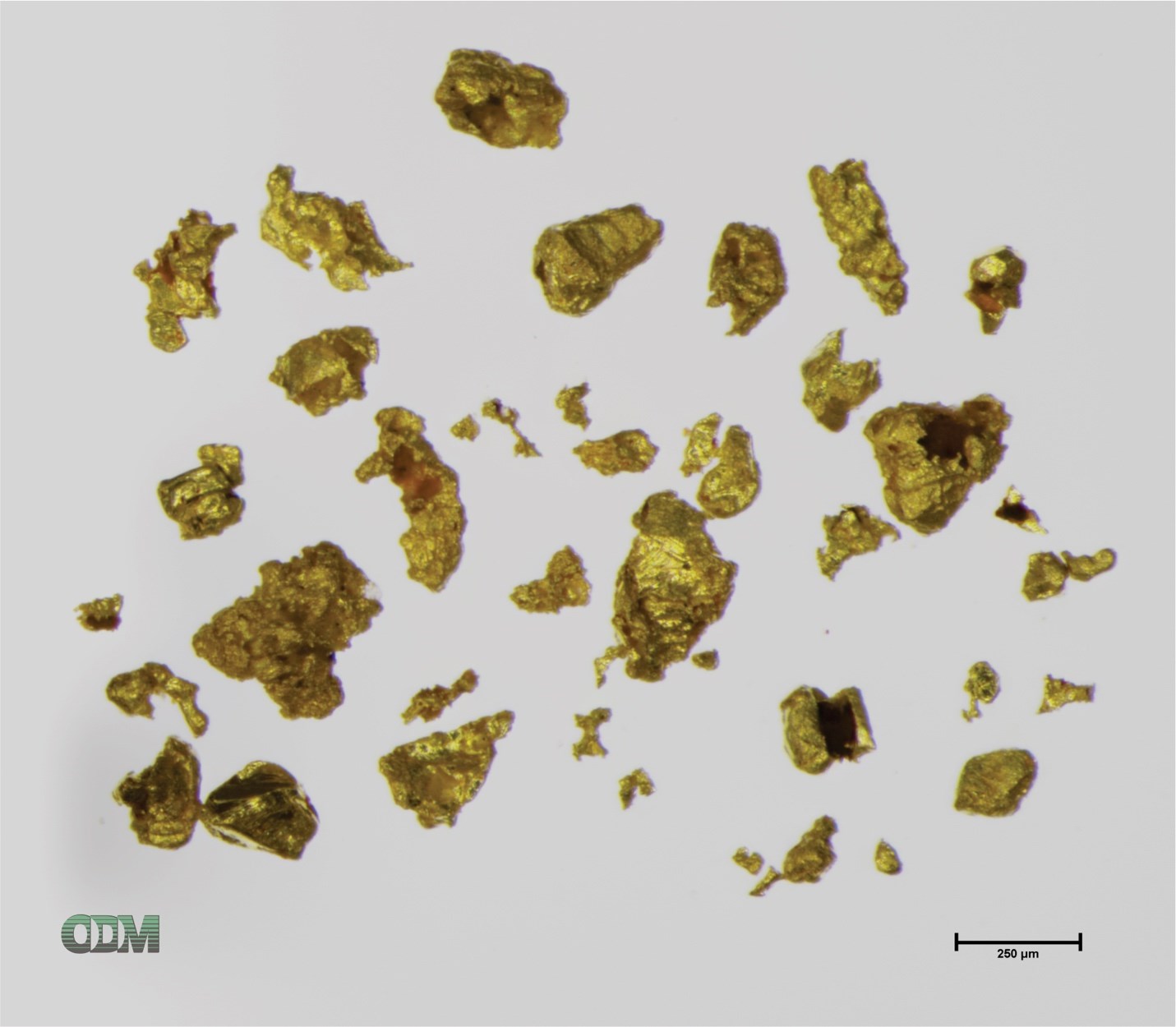
Figure 2 - Assorted gold gains from till sample No. 246. Note the large size of many grains and the very pristine condition of most grains.
To view an enhanced version of Figure 2, please visit:
https://images.newsfilecorp.com/files/5023/139533_57b68f52d45709a3_003full.jpg
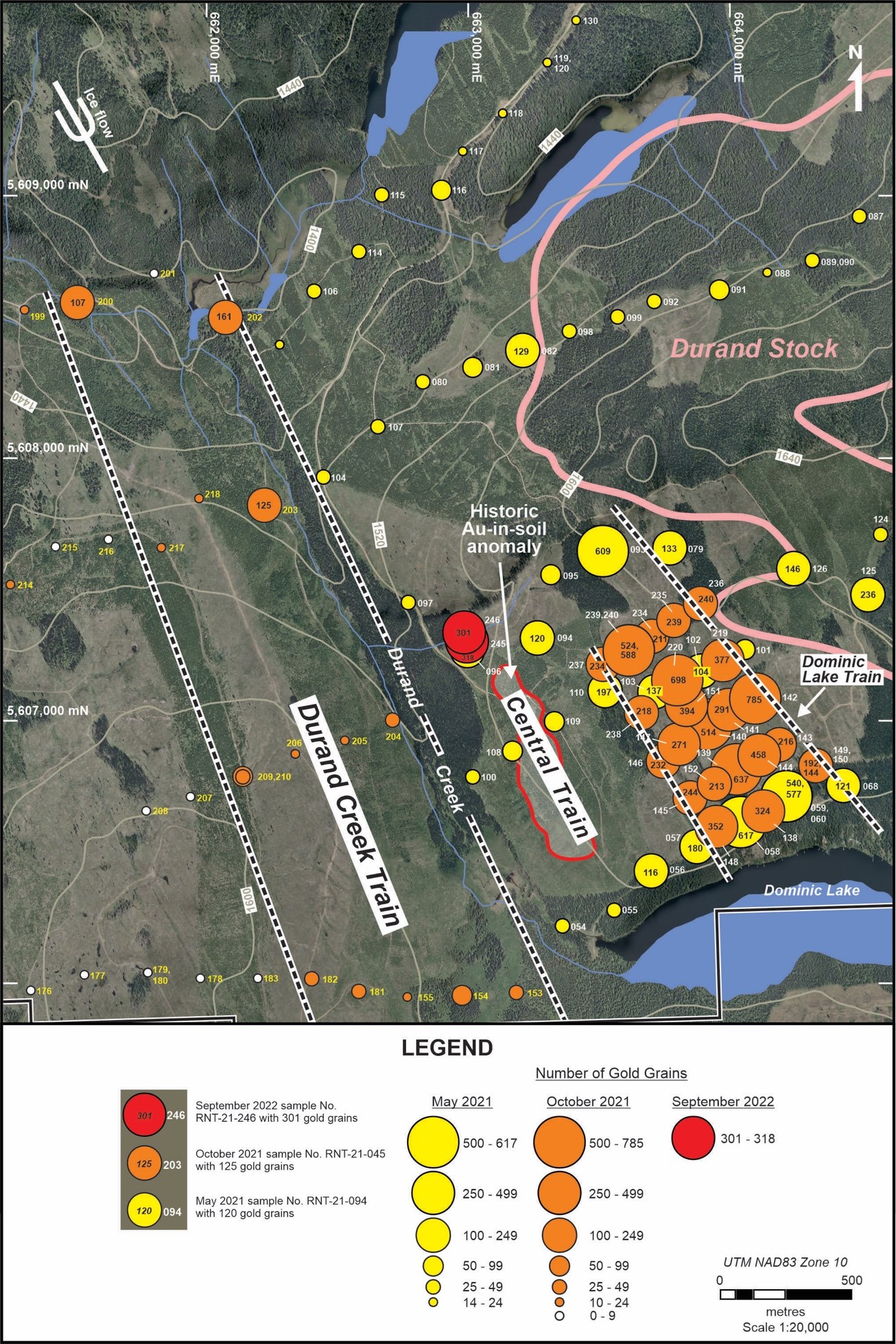
Figure 3 - Location of the new, gold-rich Central Train relative to the Dominic Lake and Durand Creek gold grain dispersal trains.
To view an enhanced version of Figure 3, please visit:
https://images.newsfilecorp.com/files/5023/139533_57b68f52d45709a3_004full.jpg
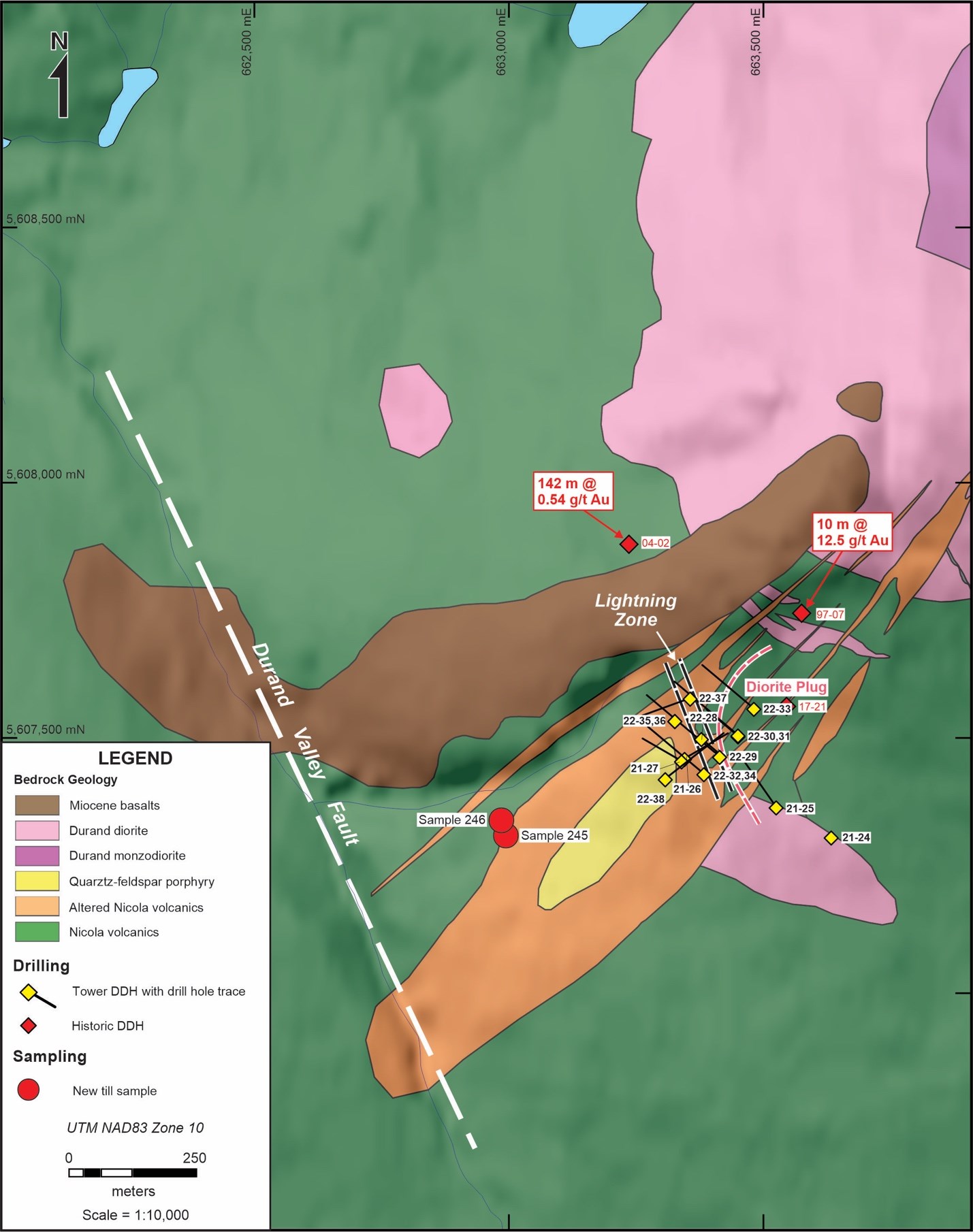
Figure 4 - Locations of the new, gold-rich till samples relative to the Lightning Zone, Durand Valley Fault and Miocene cover basalts.
To view an enhanced version of Figure 4, please visit:
https://images.newsfilecorp.com/files/5023/139533_57b68f52d45709a3_005full.jpg
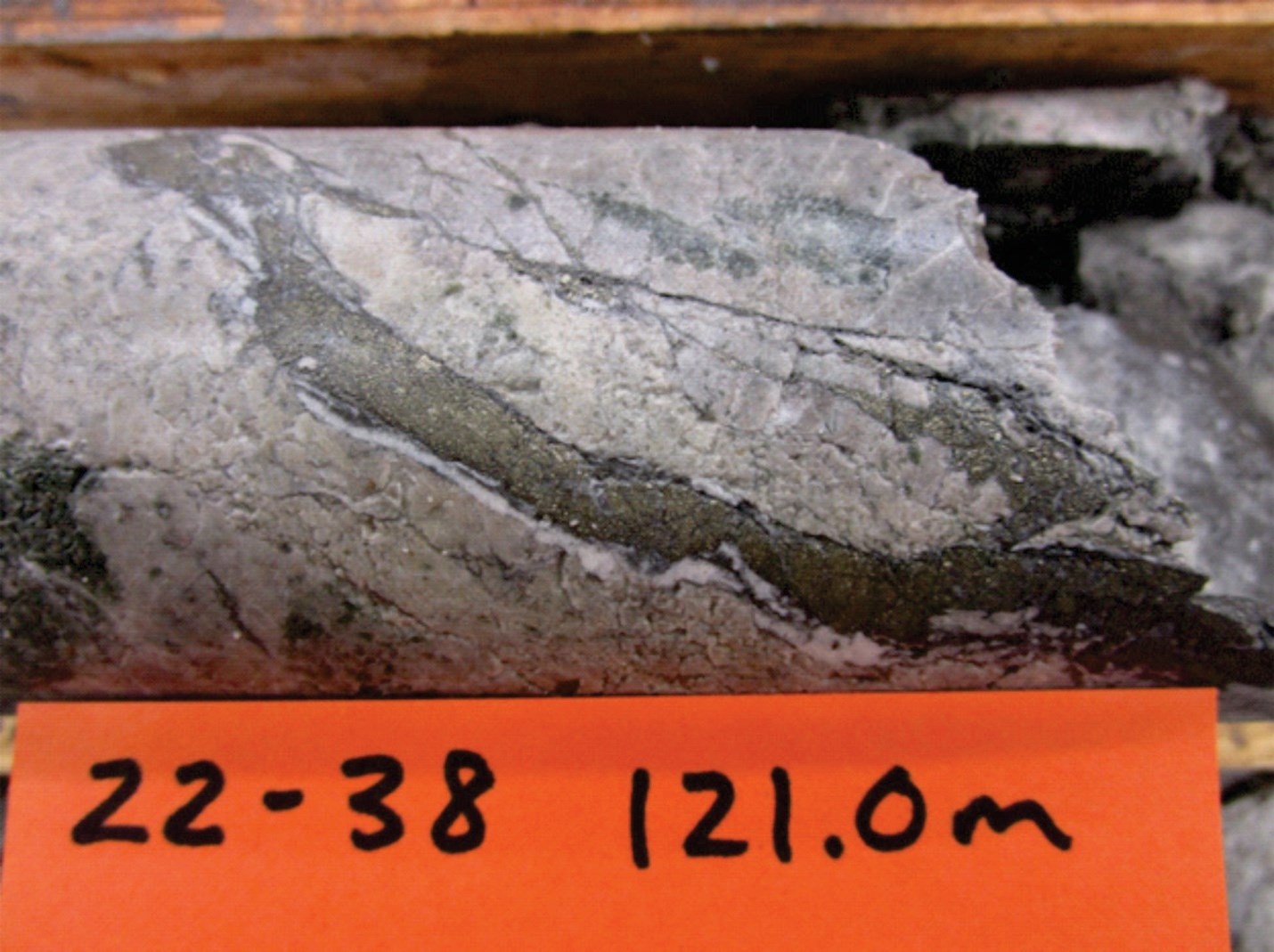
Figure 5 - Drill core from 121 m in Hole 038. Note the pervasive sericite-silicate-pyrite alternation and the presence of pyrite veinlets similar to those in the 19.2 m core section from Discovery Hole 026 that assayed 4.20 g/t Au.
To view an enhanced version of Figure 5, please visit:
https://images.newsfilecorp.com/files/5023/139533_57b68f52d45709a3_006full.jpg
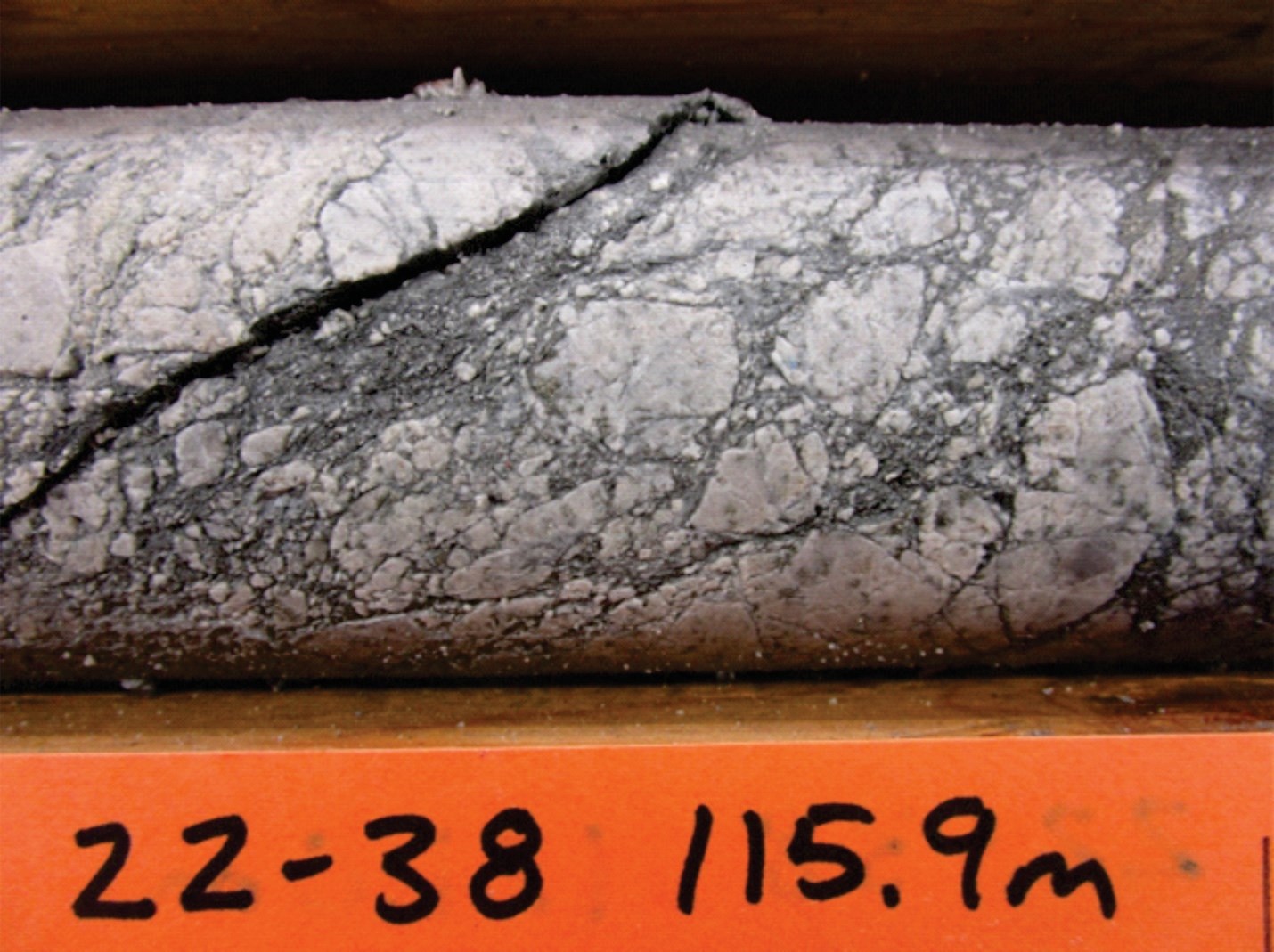
Figure 6 - Drill core from 115.9 m in Hole 038. Pyrite veinlets that were originally similar to those in Figure 5 are more strongly deformed (crushed), potentially increasing the Au grade as the mineralization is shear controlled.
To view an enhanced version of Figure 6, please visit:
https://images.newsfilecorp.com/files/5023/139533_57b68f52d45709a3_007full.jpg
To view the source version of this press release, please visit https://www.newsfilecorp.com/release/139533

